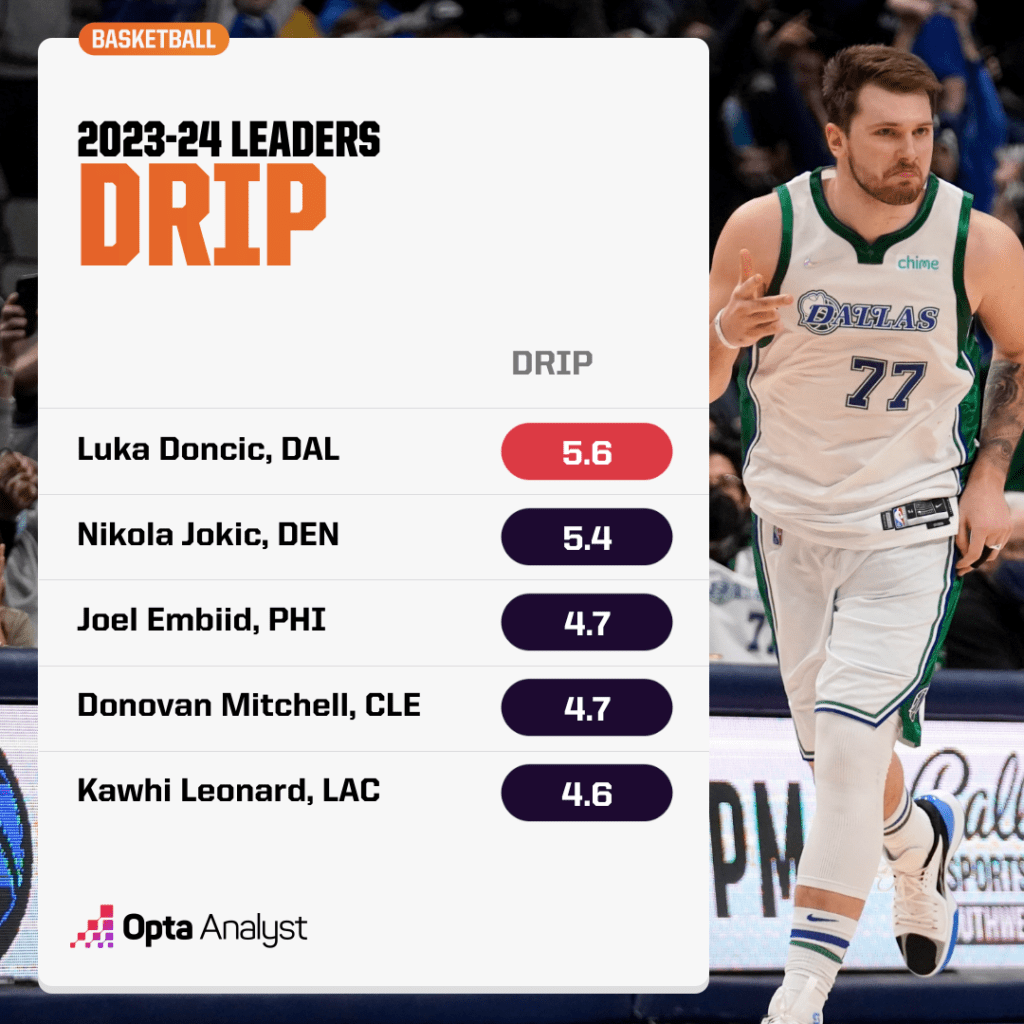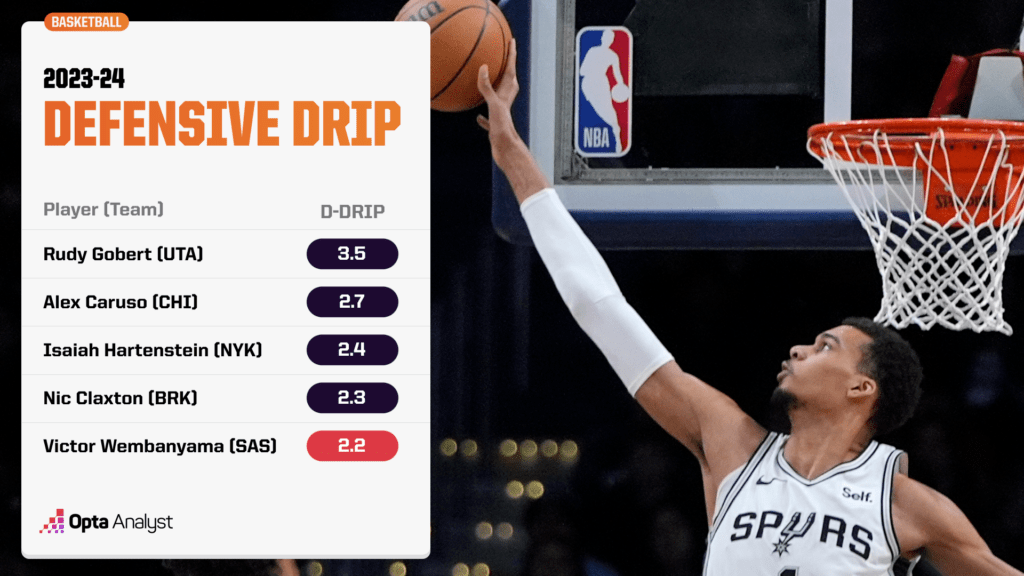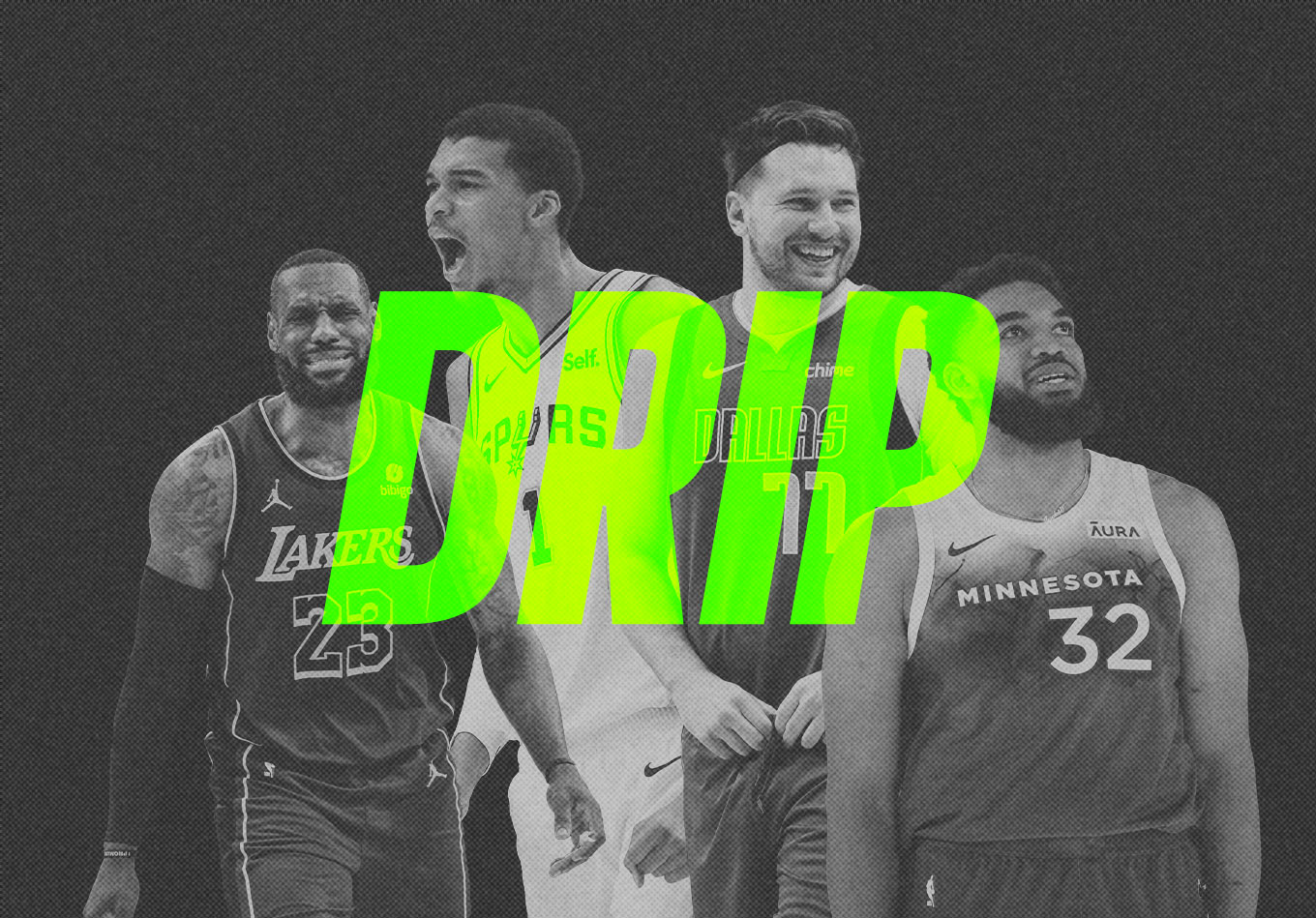As teams in the NBA return from the All-Star break, they’ll look to make key adjustments to be the best versions of themselves down the stretch.
We’ve decided to do the same thing, rolling out our new and improved DRIP earlier this week.
If you’re hearing about DRIP for the first time or simply logged in to yell at us to watch the games, check out our explainer on the metric as well as our piece explaining some commonly asked questions about the model.
What’s new and improved about DRIP? The big adjustment is using different types of models that aren’t as prone to overfitting.
Overfitting in the context of DRIP means that the model too closely assigns players’ value based on similarities to other players, even if the player is missing one or more key characteristics that make that player valuable.
In the most basic sense, imagine a player that is alike in several ways to Stephen Curry. The player shoots 3-pointers at a high volume both off-the-dribble and spotting up, plays like Curry defensively and has a good assist rate. But the player is a subpar shooter and turns the ball over a lot.
This player would obviously be penalized in a lot of ways by DRIP due to the lack of efficiency at a high volume, but, in the old version of the model, would be buoyed by a comparison in several stats to Curry. But the player is missing the most essential part of Curry’s game. His other skills are underrated, but his shooting is what makes him transcendent.
There are other elite players like this as well. Some big men might be high usage, some might be highly efficient, and some might be great passers. But none combine all three skills like Nikola Jokic, and, if players are similar to Jokic in several ways but not all three of these key ways, they aren’t the same type of player.
By giving less credit to players who have some similarities to elite players but don’t have all the similarities that make that player special, we can more accurately assign value to each player’s true skill set.
I know those reading are split into two factions: people who read the last few paragraphs with great interest and people who skipped over it hoping to see which players’ rankings are most affected.
For the latter group, the wait is over. Below is a list highlighting some of the biggest risers and fallers in the new DRIP compared to the old one, and a brief explanation as to why.
Risers
Luka Doncic, Dallas Mavericks: From No. 4 to No. 1
Doncic is the heir to prime James Harden in the sense that models love everything he can do offensively. He is an offense unto himself and creates a high floor on that side whenever he is on the court. There aren’t many players in the history of the league that combine all the skills he has offensively, especially with his usage rate.
It’s a fair question if Doncic’s usage rate makes it easier for teams to game plan against the Mavs in the playoffs (much like the questions surrounding former Harden-led teams). But it’s undeniable that Doncic has been an elite player in both the regular season and the playoffs, and the DRIP thinks his efficiency (49.2% FG, 37.5% 3PT) in a high-usage role with a fluctuating supporting cast around him make him the top player in the league.
It should be noted that Doncic’s defense improved marginally with the updated DRIP as well. He shares some characteristics with other high-usage players that struggle on defense, but his effort has been notably more consistent this year, and his height gives him a versatility that a lot of other primary playmakers don’t have.

Joel Embiid, Philadelphia 76ers: From No. 12 to No. 3
Doncic took the top spot, but Embiid is the biggest riser among players who are now in the top 10, and his new spot is much more in tune with the consensus of his stature in the league.
Keep in mind DRIP projections are for a healthy Embiid. He’s one of the few difference makers on the defensive end that also handles extremely high usage on offense.
Embiid saw a bit of a boost offensively as well, but he already graded out as a great offensive player. His ability to get to the line is exceptional, and he’s been one of the best midrange shooters in the league on a high volume this year. Hopefully, he can get back soon and remind the league just how good he is.
Tyrese Haliburton, Indiana Pacers: From No. 25 to No. 12
Haliburton is a rising star in the league, and the DRIP update gave him a significant bump on offense and defense.
Offensively, Haliburton is one of the best playmakers in the league, and DRIP projects him to have the second-most assists per 100 possessions behind only teammate T.J. McConnell, who is obviously playing a lot fewer minutes. DRIP now sees Haliburton as the sixth-most valuable offensive player in the league.
Defensively, Haliburton is still not rated highly, but he went from really bad to passably bad. This may not seem as significant, but it is. Indiana’s defensive rating is in the bottom five of the league, and there are a lot of questions about how to improve it.
If Haliburton can be part of a good defense, it’s a lot easier fix for the Pacers than if he’s a massive liability. And if he can keep inching closer to average on that end, it would go a long way toward fixing his team’s defensive woes.
Victor Wembanyama, San Antonio Spurs: From No. 38 to No. 20
Wembanyama has been like a superhero learning his powers. And the new DRIP already has him as an All-Star-level player. Wembanyama is one of the most intriguing names on the list, because his offense is actually given less credit by DRIP 2.0. The model was giving him a lot of credit for his willingness to shoot and finishing inside, but he’s only shooting 32% on 3-pointers and has more turnovers than assists. These two issues are really dragging down his offensive production.
Keep in mind that DRIP values players based on the context of their situation, and Wembanyama spent a good portion of the year playing without a true point guard to set him up. He’s looked more dynamic in lineups with traditional point guards, and his offensive DRIP will likely continue to improve while he’s in a lineup more suitable to his skill set.
Defensively? He’s already a star. He’s fifth in defensive DRIP as a rookie, with a D-DRIP over three times higher with the update. Why did his DRIP rise so much on that end? Mostly because we eliminated any of the pretenders that had some good defensive qualities (i.e. blocking and rebounding) but not all of the qualities that make someone like Wembanyama special.

Wembanyama occasionally gets bullied, but his length and athleticism affect every single play down the court. He leads the league in blocks and unofficially leads the league in times his opponent thought he had an open jumper before Wembanyama snatched it out of the air. The eye test says Wemby is already an impact defender and DRIP now backs that up.
Fallers
Donovan Mitchell, Cleveland Cavaliers: From No. 1 to No. 4
I doubt Cavs fans will be too upset about the new update dropping Mitchell from the top of the list to fourth. It would be like being upset because you split the Powerball winnings as opposed to being the sole winner. New DRIP values the unique skill sets of Doncic and Jokic a bit more than the old version, pushing them both ahead of Mitchell. But Mitchell is still much more highly regarded in DRIP than by the public consensus.
And while you might not think Mitchell is a top-five player in the league, his impact this year is undeniable. The Cavaliers have withstood major injuries and continue to roll through the league, and Mitchell has been the biggest reason why (when he wasn’t missing time himself, of course.)
With Darius Garland sidelined, Mitchell is averaging 6.3 assists, a full assist higher than his career-high of 5.3 in 2021-22. And even with a lot on his plate offensively, he’s recommitted himself to being a solid defender, and is far more consistent than his last days in Utah on that end. He’s averaging a career high in blocks, steals and rebounds as well.
It’s not just the advanced numbers that love Mitchell; the eye test and basic numbers say the same thing. You might take some other players over him, but he’s one of the true difference makers in the league.
LeBron James, Los Angeles Lakers: From No. 14 to No. 22
Wait, LeBron’s worse? Guess it’s back to the drawing board. Well, not really. Keep in mind context is key in these evaluations, and the context around James is a team that doesn’t really fit him that well.
The team is lighter on shooting and playmaking than you’d like, and this leads to a huge burden for James. For several years, he was in the Doncic mold of a player that could carry an offense by himself, but that’s no longer the case. Even with a mostly healthy and productive Anthony Davis, the Lakers are 18th in offensive efficiency this year. And it’s that side of the ball that is dragging down his DRIP in the update.
Defensively, he got a slight bump. His peak talent on defense will never be captured by advanced data because he wisely conserves his energy on so many possessions at age 39.
Darvin Ham finally got around to starting a lineup that fits together in D’Angelo Russell, Austin Reaves, Rui Hachimura, Davis and James. And Spencer Dinwiddie has been brought on to help ease the playmaking burden. If the lineup coalesces around James, don’t be surprised if James can charge up the DRIP leaderboard one more time.
Karl-Anthony Towns, Minnesota Timberwolves: From No. 18 to No. 47
Situation is everything, and nobody suffers from situation more than Towns. His offense in the updated DRIP is down a lot, which could be surprising if you just look at his scoring. He’s averaging 1.7 more points than last year and shooting a career high on 3-pointers and free throws.
So why is his offense seen as less valuable? It’s the way he is used. With Rudy Gobert around and Anthony Edwards ascending to the clear top option on offense, Towns has mostly been relegated to a tip of the spear offensive player. He’s down from 4.8 assists last year to 2.9 this year, his lowest assist per game total since 2017-18. The offense now relies on Edwards to bend the defense, and Towns has to do a lot of spotting up and attacking scrambling defenses.
He’s been shooting lights out on 3s and is averaging 22.5 points per game. But there are a lot more players who can succeed in his role now than when he was creating a lot more of his own offense and doing it efficiently. The Timberwolves could probably lean into Towns a little bit more when he has a particularly good matchup, as the team is only 16th in offensive efficiency.
But average offense and elite defense have led Minnesota to the top of the Western Conference, so Chris Finch is unlikely to shake things up now. And if the team continues to have a great season, Towns will likely be fine with DRIP and other metrics not thinking as highly of him because of his slightly reduced role.
Check out our MLB, NBA and NFL coverage, as well as our college basketball picks. Follow us on X and Instagram for more!
